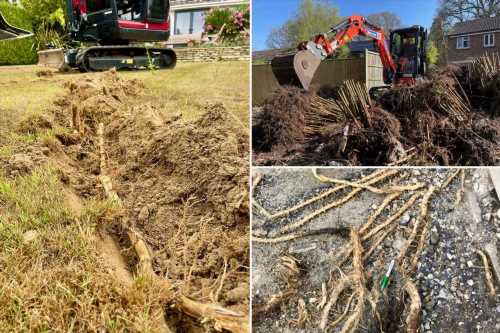A GARDENING expert has issued an urgent warning over a "highly invasive" plant that can punch through your driveway and cost you thousands.
Bamboo has been a hugely popular screening plant over the years, but frequently people aren't aware of its potential to cause damage.



Bamboo is a non-native plant species that can grow and spread at a different rate in the UK than it does in its native habitat.
Generally bamboo can be divided into "running" and "clumping" varieties, with the former being the greater cause for concern.
Running varieties can send out stem-like structures, called rhizomes, several metres long.
When these rhizomes emerge they form the start of what will become new canes in new locations.
Read more News
 WEED IT OUT
WEED IT OUT
Warning over plant that’s worse than Japanese Knotweed & knocks value off homes
 KNOTTED UP
KNOTTED UP
Map reveals worst areas for Japanese knotweed amid house price warning
The typical bamboo damage heard about is caused by rhizomes.
Many parallels can be drawn with Japanese knotweed, now commonly known to be a highly problematic plant.
One major difference is that many people "choose" to plant bamboo.
Jon Barton, managing director of Root Barrier Store, described how allowing the plant to spread over a neighbouring boundary and failing to act could leave you liable for removal, repair and legal costs.
Most read in The Sun
 ROAD RAGE FURY
ROAD RAGE FURY
Foul-mouthed motorist unmasked after hurling horrific abuse at driver
 SICKO FANS
SICKO FANS
Cops arrest two after football yobs ‘taunt’ fans with Bradley Lowery pic
 HELL STATE
HELL STATE
Torture, beheadings & gang-rapes: how rural region became militant-run warzone
 hot water
hot water
Holly Willoughby ‘told not to wear a bra’ by kids TV bosses in new misogyny row
He told the Sun: "Bamboo is a marvellous example of nature at its resilient best.
"If bamboo's characteristics were paralleled with human qualities, it would be a soldier, a marine or a SAS operative.
"It is incredibly tenacious, strong and able to survive where other plants can't.
"Allowing bamboo to encroach onto a neighbouring property can cause disputes.
"However, when it starts to spread under the neighbour's tarmac and pushes up towards the daylight, it then becomes a costly problem to resolve.
"Frequently, a new drive becomes necessary because a patch-up won't resolve the underlying issue.
"We've seen runners create undulation and ripples in tarmac surfacing, followed by shoots that push up through the tarmac."
He continued: "We routinely extract runners that extend over 3m.
"The longest intact runner we have removed was more than 5 metres, but runners over 10m in length have been uncovered.
"Lawns are where the longest runners reside; here it is easy for them to fulfil their growth potential and reach greater distances.
Read More:
 BIG REWARD
BIG REWARD
Katie Price's fiancé Carl Woods offers £5k reward after Range Rover is stolen
 star gone
star gone
Lock, Stock and Two Smoking Barrels star Jake Abraham dies aged 56
"It is common to see Bamboo that was planted inside a border later sending out runners.
"These can easily straddle one garden and then end up in the next!"



What’s the solution to bamboo that is running rampant?
There really are only two solutions: "removal" or "containment" with root barrier (bamboo barrier).
Herbicide treatment is possible for small shoots, but wouldn't work on a large established stand of bamboo.
Removal
Can be highly labour intensive.
There is a need to remove the main plant, often using a stump grinder for the area under the main plant, followed by chasing out any remaining rhizome.
Containment
If you've got bamboo, at a minimum, you should contain it!
By blocking it you'll do that; however, this will require a specialist root barrier that is extremely flexible with a high puncture resistance to prevent invasive rhizomes.
A barrier with a puncture resistance of at least 4000 Newtons CBR is recommended.
CBR (California Bearing Ratio) relates to the force that can be applied to the material, before it will puncture or fail.
Source: Read Full Article


